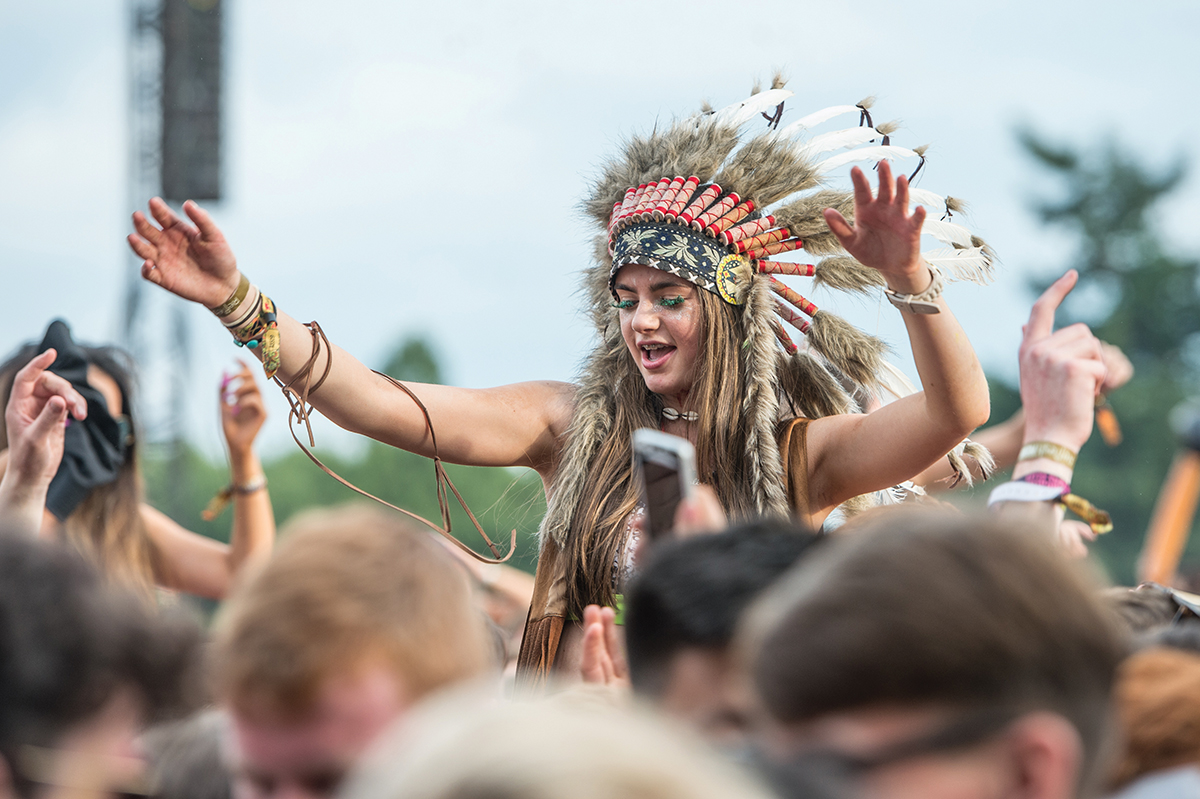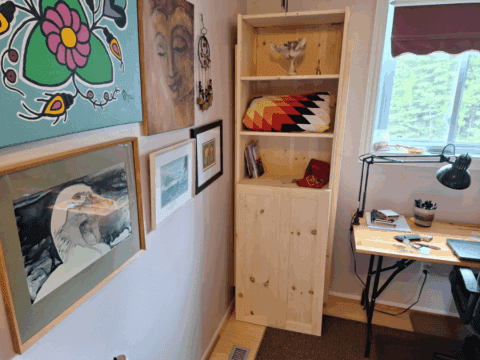At the beginning of this school year, a class of Grade 3 students and their parents arrived at a Montreal school to find their teachers wearing cheaply made “Indian” headdresses — the kind you’d find at the back of a dusty dollar store.
Even five years ago, this probably wouldn’t have been news. But in September 2016, it made headlines across Canada and beyond. Introducing Quebec’s Indigenous history into the curriculum, the school board’s spokesperson later noted, was the teachers’ motivation for wearing the garishly dyed feathers — and for distributing paper headdresses to their students as well.
One feisty parent took a photo and complained on Facebook. Within a day, national television and newspapers were shaming the teachers in a crackdown against the latest cultural sin: disrespectfully grabbing another culture’s important stuff without permission.
My first reaction: how did this happen?
A little more than a year before, Montreal’s Osheaga Music and Arts Festival made news for banning First Nations-inspired headdresses on site. You’d think the Grade 3 teachers, who appear to be music fest-aged millennials, would be savvy enough to not wear them to school. I mean, geez, white people. Wearing First Nations ceremonial attire as fashion is, like, Cultural Appropriation 101. You just don’t do it.
But then I remembered: this is pretty new. In the mid-1990s, I was a university student who volunteered as a docent at the Museum of Vancouver. Part of my duties involved leading Grade 4 students through a faux potlatch, handing their leaders a talking stick, greeting the other “tribe” and performing a naming ceremony. It was the same program I’d experienced as a kid. So respectful then, it seemed. So obviously misguided now.
To be fair, screwing up is easy. The offending Grade 3 teachers live in a Canada that’s evolved far beyond maple syrup and hockey. In their daily lives, they’re as likely to consume kundalini yoga, Bollywood movies, Zen meditation, bubble tea, Day of the Dead T-shirts and shawarma as they are poutine and pancakes.
In the United Church alone, encounters with the songs, clothing, symbols and practices of other cultures is constant: the Huron Carol, Guatemalan stoles, Celtic and Coptic crosses, four-direction prayers.
What is okay to consume and wear? What’s the difference between appreciation and appropriation? And why? Well, that’s an evolving conversation.
The latest alleged offender is Wenjack author Joseph Boyden. Questions about his ethnic identity swirled in late 2016. He initially declined to comment beyond a statement on his Twitter account claiming his mixed heritage: Celtic, Nipmuc and Ojibwa. So far, he hasn’t satisfied skeptics with “proof.”
Criticizing cultural appropriation dates back to the late 1980s, when academics began questioning whether non-Indigenous authors should be writing about the Indigenous experience, especially in the first person — such as W.P. Kinsella’s Hobbema stories.
By 2011, appropriation hit the mainstream with Ohio University’s student-led Halloween campaign “We’re a culture not a costume,” which urged youth to avoid dressing up as, say, sexy Pocahontas. In 2013, Canadian DJ collective A Tribe Called Red famously asked its fans to stop wearing headdresses to concerts. In July 2015, Osheaga banned headdresses. That summer, the Truth and Reconciliation Commission’s 94 calls to action included one that seemed to address appropriation: that Canadians obtain “the free, prior, and informed consent of Indigenous peoples before proceeding with economic development projects.”
But that didn’t stop us.
Later that year, Canada’s Paola Nunez bared her midriff above a totem pole loincloth, balancing a sparkling eagle headdress as she walked in the Miss Universe national costume parade in Las Vegas.
Jessica R. Metcalfe, a Turtle Mountain Chippewa academic from North Dakota, roundly slammed the costume on her fashion blog Beyond Buckskin. “While the Canadian public is so rife with violent racist attacks against Native people that CBC . . . had to take action and shut down the comment sections on all stories about Aboriginal people (even the stories about our stolen sisters), it’s interesting that the same populace proudly trots out a non-Native representative of their nation in an Aboriginal-themed costume,” she wrote. “Is the only good Indian a non-Indian in an Indian costume? Hell, what other message is being sent with these contradictory actions? . . . Why are we consistently excluded from having a say in how our cultures are being represented?”
‘Why are we consistently excluded from having a say in how our cultures are being represented?’
In response to our many missteps, the Intellectual Property Issues in Cultural Heritage research project at Simon Fraser University published, in early 2016, Think Before You Appropriate: A Guide for Creators and Designers. Helpfully, it offers principles for avoiding appropriation: free, prior and informed consent; shared control over process and product; acknowledgment and attribution; respect for cultural differences; and reciprocity and benefit sharing.
As valuable as the guide is, blundering white North Americans have been ubiquitous in recent headlines. Last September, Quebec-based Ungava Spirits Co. finally apologized for using Inuk imagery to sell its alcohol — including employing a small army of young female buzz marketers in skin-tight “parka” minidresses. In October, during the 2016 American League Championship Series in Toronto, the Cleveland Indians met resistance, including a “#NotMyMascot” United Church-supported protest, regarding the team’s name and Chief Wahoo logo.
As journalists and academics warred over the boundaries of appropriation, the deeper conversation was lost. Why do non-Indigenous Canadians appropriate Indigenous culture in the first place?
To answer this question is to journey into a most uncomfortable area: thinking about white culture. Thanks to the Oval Office’s newest occupant, it’s unavoidable. The swift unveiling of the “alt-right” white supremacist movement, the rise of racial hate crimes and the strong white vote in favour of Donald Trump have thrust whiteness into the spotlight. And if you scan through recent images of music festival-goers on Google, there are a lot of white faces crowned with feathers. In the words of Buffalo Springfield, there’s something happening here.
The clearest explanation I was able to find is by Jamie Utt, an inclusivity consultant in Minneapolis who blogs for Everyday Feminism and The Good Men Project. He argues that white North Americans are hitching their wagons to First Nations culture because they’re detached from their own European roots. For him, figuring out who he is — beyond being an “ally” — is a key to deeper, more authentic reconciliation.
“Reclaiming who my people were before we were colonizers means understanding my Irish, German and Dutch heritage, yet I know next to nothing about my people and the cultures from whence they came,” he writes. “Why? Well, because they became White.”
Whiteness, Utt posits, is a North American phenomenon characterized by forgetting one’s heritage: the language, religion, songs and skills of one’s ancestors, in favour of the American dream. Skin colour isn’t its primary marker. Instead, “whiteness” means a void, like a blank sheet of paper. A newly arrived Lithuanian immigrant wouldn’t be “white” by Utt’s definition. But her grandchildren — who don’t speak her language and can’t knit a mitten — might be white.
Consequently, when North American white people go looking for a cultural core, they instead find a vacuum, and a longing to fill it. They’re living in a multicultural North America without an ancestral identity, like agnostics at an interfaith dialogue.
It seems that young white North Americans have found four strategies to fill that void. First, with white supremacy — creating a narrative about a new and powerful nation. Second, by latching on to nearby cultures — often First Nations, but also others. Third, by accepting the trade — exchanging language and tradition for Coach bags and condos, the comforts and status symbols of mainstream North American life. And fourth, as Utt recommends, by looking backwards beyond remembering, to rekindle a relationship with those European roots.
This fourth strategy was sprung on me, unsolicited, in the most unusual of places: at my son’s Grade 2 May Day celebrations at James Thomson Elementary School in Powell River, B.C. His school is near the offices of the Tla’amin Nation, a pioneer in integrating First Nations culture into public schools.
My son, who is white, takes Tla’amin language classes, visits salmon rivers, learns local stories and much more. Cultural events are Tla’amin-initiated and Tla’amin-led. No white teacher would ever show up here in a feather headdress.
So it wasn’t a surprise when, under a bright blue sky, May Day began with Tla’amin language prayers and drumming by elders, or when the kindergartners, who are mostly Tla’amin and white, presented a Coast Salish friendship dance in tiny red-and-black button blankets. Behind my aviators, I was already misty.
After the friendship dance, the teachers set up a wooden maypole adorned with pink, blue and yellow ribbons. I’d never before seen the medieval European dance performed and had only a vague idea of what it was about.
My son, along with each of his classmates, grasped a ribbon and stood in position with his hands on his hips. A recorded flute tune sounded over the loudspeakers, and the children swirled into action, skipping, ducking and weaving through one another. An emotion I didn’t even know I possessed grabbed my heart and squeezed. The centuries-old springtime fertility ritual was brought to life, here on the B.C. coast.
Instead of being invited into someone else’s revitalizing culture, my own ancient, forgotten, broken European culture was raised from the dead in that schoolyard, a miracle witnessed by all of us — Aboriginal and European. I felt both the bliss of familiarity and intense grief for the wide, empty chasm between my ancestral roots and my 21st-century Canadian self.
In that moment, I wasn’t just a settler or an ally. I was also myself — a person with a complicated and fractured relationship to my own ancestral heritage.
Reconnecting to long-forgotten Europe is clearly something that other white people are interested in. The exponential growth in online ancestry research and in DNA testing reveals that roots-detached North Americans are clawing their way backwards in search of identity.
And yet, this is uncomfortable ground.
I am a white writer turning an essay about appropriating First Nations culture into a story about white people — a self-aggrandizing, though typically white approach. But here we are, bedecking ourselves in dollar-store headdresses, singing about Gitchi Manitou and swilling Ungava gin. How bereft we must be of our own cultural identity, how very insecure.
Of the four strategies that culturally blank Canadians are adopting — white power, appropriating, crass consumerism and reconnecting to their roots — it’s the latter, reconnecting, that offers the best hope for reconciliation.
Part of reconciliation with First Nations will simply mean establishing some basic rules of conduct: no pretending to be Aboriginal when you’re not; no stereotypical symbols such as the Chief Wahoo logo; no wearing a sparkly totem pole bikini on international TV without first seeking permission.
But for white people, there’s an even higher calling than avoiding past errors.
Reconciliation also means remembering who we are, so we can — with our whole selves present — meet the other.
This story first appeared in the March 2017 issue of The Observer with the title “Culture thieves.”















